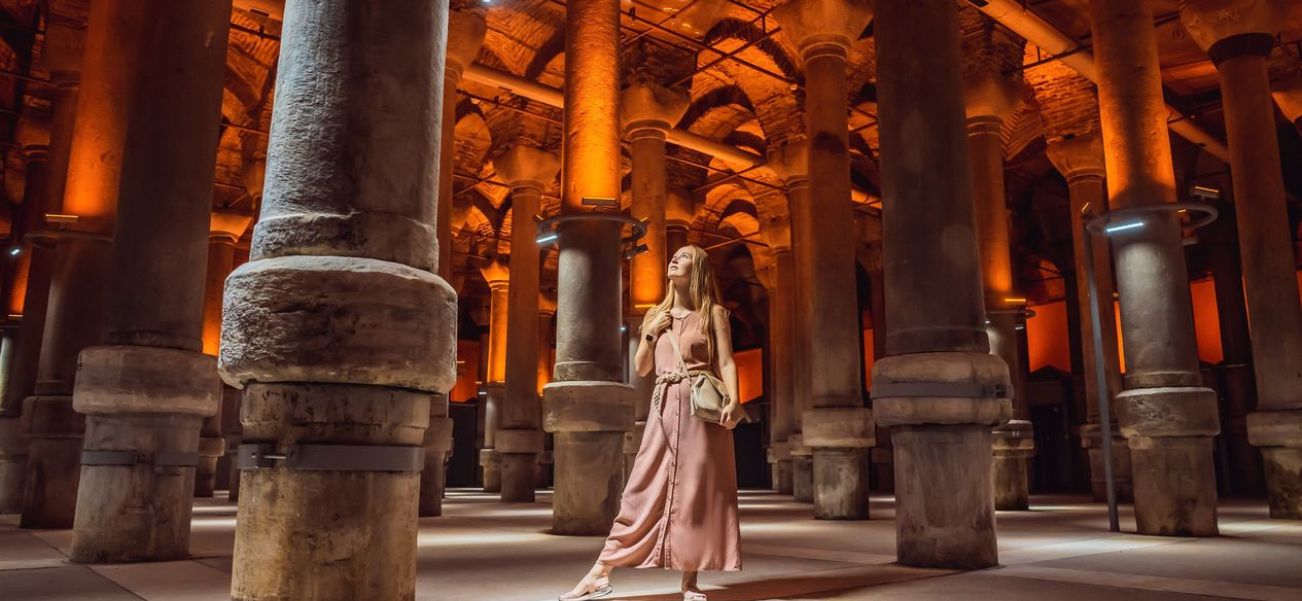
The Basilica Cistern: A Hidden Gem Beneath Istanbul's Bustling Streets
Beneath the vibrant, chaotic heart of modern Istanbul, where the echoes of ancient empires whisper through the streets, lies a silent, sublime world. While millions of visitors crane their necks to admire the soaring domes of the Hagia Sophia and the majestic silhouette of the Blue Mosque, a different, equally profound experience awaits just a few steps away. Descend into the cool, damp darkness, and you will find yourself in the Basilica Cistern ("Yerebatan Sarnıcı" in Turkish), a breathtaking subterranean palace that is truly one of Istanbul's most captivating hidden gems.
This is not merely a historical site; it is an atmospheric journey into the ingenious engineering of the Byzantine Empire, a place where history, myth, and art converge in a forest of marble and water. For anyone seeking to move beyond the standard tourist trail and connect with the soul of this ancient city, the Basilica Cistern is an unmissable destination.
BASILICA CISTERN: ISTANBUL'S HIDDEN WONDER
Listen to this audio book about the Basilica Cistern:
Hagia Sophia: A Timeless Masterpiece in Istanbul
A Monument to Survival: The Historical Context of the Basilica Cistern

To understand the Basilica Cistern is to understand the very lifeblood of Constantinople, the capital of the Eastern Roman (Byzantine) Empire. Founded by Emperor Constantine the Great, the city was a powerhouse of culture, religion, and trade. However, its location on a peninsula made it vulnerable to siege, and a reliable source of fresh water was a constant strategic concern.
The city's original aqueducts and cisterns became insufficient for its growing population and grandeur. Thus, Emperor Justinian I, the same visionary ruler who commissioned the Hagia Sophia, ordered the construction of this colossal underground reservoir in 532 AD. It was built on the site of a former Stoa Basilica, a grand public square, hence its name.
The cistern's primary function was pragmatic: to store and filter water transported via the Valens Aqueduct from reservoirs near the Black Sea, ensuring the Great Palace and surrounding buildings had a steady supply, even during prolonged droughts or attacks. For centuries, it performed this vital role silently and efficiently.

After the Ottoman conquest of Constantinople in 1453, the cistern was largely forgotten by the palace, which preferred running water. It was "rediscovered" in the 16th century by the Dutch scholar Petrus Gyllius, who was investigating local legends of residents lowering buckets into holes in their basements and hauling up fresh water—and even fish! His rediscovery brought the Basilica Cistern back into the world's consciousness, leading to several restoration projects, first by the Ottoman authorities and later by the modern Turkish Republic.
Istanbul's Byzantine Gems: Exploring Constantinople's Legacy
Engineering Marvel: The Architecture and Scale of the Basilica Cistern

The statistics of the Basilica Cistern are staggering, even by modern standards. This underground chamber measures approximately 138 meters (453 feet) by 65 meters (213 feet), covering a total area of almost 9,800 square meters—roughly the size of two football fields. Its capacity was a phenomenal 80,000 cubic meters (over 21 million gallons) of water.
The roof is supported by a forest of 336 marble columns, each standing 9 meters (30 feet) high. These columns are arranged in 12 rows of 28, creating a seemingly endless colonnade that stretches into the shadowy distance. The engineering brilliance lies in the reuse of materials. The columns were spoliated—repurposed—from earlier Roman temples and ruins, a common practice that saved resources and infused the structure with a layer of borrowed history. You can see a variety of Corinthian and Doric capitals crowning the columns, each with subtle differences.

The walls, 4.8 meters (16 feet) thick and made of firebrick coated with a special waterproofing mortar, have withstood the test of time and the immense pressure of the water and earth around them. The entire structure is a testament to Byzantine engineering prowess, a masterpiece designed not for show, but for sheer, enduring utility.
Istanbul Archaeological Museums: A Portal to Ancient Civilizations
The Enigmatic Guardians: Medusa and the Hen's Eye
While the sheer scale of the cistern is awe-inspiring, its most famous features are two enigmatic column bases that have fueled myths and legends for centuries. These are the Medusa Heads and the Hen's Eye Column.
The Medusa Heads

In the far northwestern corner of the cistern, two columns rest on massive, carved heads of Medusa, the Gorgon from Greek mythology whose gaze could turn men to stone. One head is positioned sideways, the other upside down. The origin and purpose of these pagan sculptures in a Christian Byzantine structure remain one of Istanbul's great mysteries.
The prevailing theory is that they, like the columns, were spoliated from a Roman building, likely a temple dedicated to the gods. Placing them upside down and sideways was perhaps a practical solution for achieving the correct column height. However, some suggest it was a deliberate act by the Christian Byzantines to neutralize the power of the pagan idol, rendering its petrifying gaze harmless by positioning it disrespectfully.
Another theory posits that they were simply used as sturdy, readily available marble blocks. Regardless of the reason, the Medusa heads now serve as the cistern's most iconic and photographed feature, their stoic, inverted faces reflecting eerily in the water, captivating visitors with their silent, stony mystery.
The Hen's Eye Column (Tear Column)

Another poignant feature is the so-called Hen's Eye Column or the "Column of Tears." Located in the far left corner from the entrance, this column is ornately carved with peacock eyes, feathers, and what appear to be twisting, upward-flowing tears. The peacock was a symbol of immortality in Byzantine art, but the tears are often interpreted as a tribute to the hundreds of slaves who died during the cistern's construction.
Visitors often follow a local tradition: insert your thumb into one of the holes in the column, rotate your hand 360 degrees, and make a wish. The smooth, worn surface of the carving is a testament to the countless hopes and dreams whispered in this dark corner over the ages.
A Sensory Experience: The Atmosphere of the Subterranean Palace

Visiting the Basilica Cistern is a profoundly sensory experience. As you descend the 52-step stone staircase, the temperature drops and the humid air fills your lungs. The bustling sounds of Sultanahmet Square—the calls to prayer, the chatter of tourists, the hum of traffic—fade into a distant murmur, replaced by the steady, melodic drip of water.
The lighting is deliberately atmospheric. Soft, golden spotlights and colored gels strategically illuminate the columns, casting long, dramatic shadows and creating mesmerizing reflections on the still, dark water below. The wooden walkways wind through the colonnades, allowing you to wander at your own pace, feeling the immensity of the space envelop you.

Until recently, the cistern was home to a population of large, ghostly carp fish that glided through the submerged depths. While removed during the most recent restoration for their own well-being, they were long part of the cistern's mystical charm. Today, the water is clearer, enhancing the mirror-like reflections and allowing you to see the intricate details of the submerged column bases.
The combination of the cool, damp air, the hypnotic play of light and shadow, the grandeur of the architecture, and the weight of centuries of history creates an ambiance that is at once serene, mysterious, and unforgettable. It’s a place that appeals not just to the historian, but to the poet and the dreamer.
The Basilica Cistern in Popular Culture

The otherworldly beauty of the Basilica Cistern has not gone unnoticed by the world of fiction. Its dramatic setting has made it a favorite location for filmmakers and authors, further cementing its status as a global icon.
Most famously, it served as a backdrop in the 1963 James Bond film "From Russia with Love", where Bond paddles through the columns in a small boat. It also featured prominently in the 2009 film "The International", and more recently, it inspired the "Sunken Library" in the video game "Assassin's Creed: Revelations". Dan Brown's bestselling novel "Inferno" also features a thrilling sequence set within the cistern, bringing its enigmatic atmosphere to millions of readers.
This pop culture presence has introduced the cistern to audiences who may never have heard of it, transforming it from a niche historical site into a must-see landmark for a new generation of travelers.
The Grand Restoration and Modern Visits

The Basilica Cistern underwent a massive and comprehensive restoration project between 2017 and 2022. It was closed to the public for five years as engineers and archaeologists drained the water, cleaned centuries of silt and mud from the floor, repaired the brickwork, and installed a new, state-of-the-art lighting and walkway system.
The result is spectacular. The cistern is now more accessible and visually stunning than ever. The new lighting system uses LED technology to highlight architectural features without damaging the ancient structure, and the water is filtered and maintained at a consistent level. The restoration also revealed previously unseen sections of the cistern, deepening our understanding of its construction.

Planning Your Visit: Practical Tips
- Location The entrance is directly across the street from the Hagia Sophia, in the heart of the Sultanahmet district.
- Tickets It's highly recommended to book your tickets online in advance to avoid long queues, especially during peak season (April-October).
- Best Time to Visit Early morning right at opening time, or later in the afternoon, to avoid the largest crowds. The atmosphere is particularly magical when it's less crowded.
- Accessibility There is a staircase to descend and ascend. The walkways are flat and even, but the environment is damp.
- What to Bring A light jacket is advisable as it can be cool and damp inside. Your camera is a must, but remember to turn off the flash to preserve the ambiance for others.
- Duration Plan to spend at least 45 minutes to an hour to fully appreciate the space.
Beyond the Basilica: Other Cisterns of Istanbul

While the Basilica Cistern is the largest and most famous, it is just one of hundreds of ancient cisterns hidden beneath Istanbul. Another notable example is the Şerefiye Cistern (Theodosius Cistern), located near the Grand Bazaar. Built earlier than the Basilica Cistern, it is smaller but boasts beautifully preserved columns and a more intimate, equally atmospheric setting. Visiting both offers a fascinating comparative look at Byzantine hydraulic engineering.
Conclusion: More Than a Tourist Attraction

The Basilica Cistern is far more than a checkmark on a tourist itinerary. It is a portal to another time, a silent witness to the rise and fall of empires. It represents the pragmatic genius of the Byzantines, the layered history of a city built upon its own past, and the enduring power of mystery and beauty.
In a city defined by its magnificent skyline, the Basilica Cistern offers a powerful reminder that some of the greatest treasures are not always the most visible. They lie in wait, hidden in plain sight, inviting us to descend, to explore, and to marvel. It is a place that captures the dual soul of Istanbul—a city of light and shadow, of the monumental and the secret, forever poised between East and West, past and present. To walk its wooden paths is to walk through history itself, and to emerge back into the sunlight is to carry a piece of its profound and mysterious calm with you.
Ready to explore? Add the "Basilica Cistern" to your Istanbul itinerary and uncover the secrets beneath the streets!
Enjoy your trip to Istanbul!













